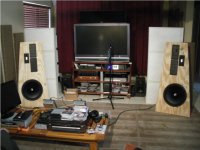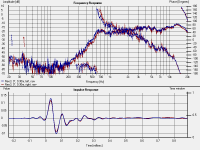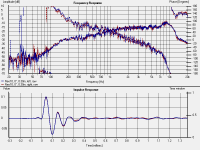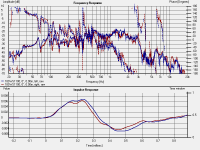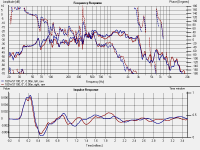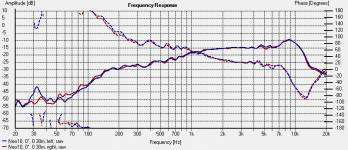I have not done distortion on the Dipole 15 yet, but it is coming soon.
I see that you have mentioned several times that you could use some "diffusion" on the ceiling btw you and the speakers. Do you mean "absorption"? Would seem like the better choice for the first reflection point.
I am building and/or acquiring a lot room treatments myself to help out with problems in my room. I MAY do some diffusion on the rear wall behind me, but absorption only at the first reflection points. I'm working on building a large "cloud" for the ceiling.
Greg
I see that you have mentioned several times that you could use some "diffusion" on the ceiling btw you and the speakers. Do you mean "absorption"? Would seem like the better choice for the first reflection point.
I am building and/or acquiring a lot room treatments myself to help out with problems in my room. I MAY do some diffusion on the rear wall behind me, but absorption only at the first reflection points. I'm working on building a large "cloud" for the ceiling.
Greg
Cool. Look forward to seeing your data.
Diffusion, absorption, scattering, dispersion, I don't know. Anything I put up needs to be fairly noninvasive and easy to take down when I move, which makes it hard to get a consistent NRC down to ~30Hz. Have to think about it for a while and see what I come up with, but any significant revisit of room treatment will comes after the power amps are done.
Diffusion, absorption, scattering, dispersion, I don't know. Anything I put up needs to be fairly noninvasive and easy to take down when I move, which makes it hard to get a consistent NRC down to ~30Hz. Have to think about it for a while and see what I come up with, but any significant revisit of room treatment will comes after the power amps are done.
Cool. Look forward to seeing your data.
Diffusion, absorption, scattering, dispersion, I don't know. Anything I put up needs to be fairly noninvasive and easy to take down when I move, which makes it hard to get a consistent NRC down to ~30Hz. Have to think about it for a while and see what I come up with, but any significant revisit of room treatment will comes after the power amps are done.
Well, I think down to 30Hz is a little optimistic, but even good results down to say 100-200Hz would be very beneficial. Not too difficult with some plain rigid fiberglass panels spaced off the wall a little or some Bonded Logic. We have been experimenting a lot lately with new treatments for the control room at the studio and just a 2*4 panel placed btw the mains on the front wall and another at the side wall, first reflection points makes a world of difference to center image clarity and stability AND image width.
I feel that so many diyers get mesmerized by the things that even modest dipoles do well, that they kind of forget other aspects of sound that are maybe diminished by dipoles in TOO live of a room. There is a difficult compromise to make between spaciousness and having discernible image location other than just hard left and right. I've heard many dipole systems that are just a diffuse wash of sound anywhere across the middle. It's not the speakers fault per say, just TOO MANY reflections bouncing around. I guess it might be nice for large orchestral works, but anything studio produced or close mic'd always sounds wrong.
Just the two Mondo traps placed close behind my protoypes have really cleared up a very wishy washy soundstage and given me back a pretty stable center image. Can't wait to get the ceiling cloud up.
Greg
Attachments
Nice speakers!
Well, I know JohnK and I would disagree with that. He has used S-plane math to show that dipoles are minimum phase in their passband. I have modeled it as two point sources in LspCAD and came up with the same thing. The 6dB dipole rolloff causes a 90 degree phase shift just like a 6dB highpass filter.
But enough about that. Great job on the speakers.
Great job on the speakers.
However (as has been discussed over in the Arbitrator forum at Thuneau) dipole rolloff does not induce a phase shift and wants linear phase phase equalization.
Well, I know JohnK and I would disagree with that. He has used S-plane math to show that dipoles are minimum phase in their passband. I have modeled it as two point sources in LspCAD and came up with the same thing. The 6dB dipole rolloff causes a 90 degree phase shift just like a 6dB highpass filter.
But enough about that.
Agree; for most reasonable room treatments the bass off the 18s will still be reflecting but at least you've knocked out most of the audible signal and reduced the size of the effective source.Well, I think down to 30Hz is a little optimistic, but even good results down to say 100-200Hz would be very beneficial.
What are you planning for your ceiling cloud? What with renting my options are limited but the most straightforward thing I might be able to get away with is hanging a drop ceiling type frame across the worst of the first reflection area and loading it with tiles. Sonex claims pretty good bass NRC for their Contour and Harmoni tiles, but they're also pretty spendy.
Thanks!Nice speakers!
As the part of this conversation about rooms shows, no project of mine is every really done and I'm always looking for improvements. Can you help me by pointing out where in the attached measurements the 90 degree phase shift from the dipole roll off is? For the first three data's ungated, unsmoothed, and there's no equalization or arbitration (as normal for HOLMImpulse solid lines are SPL for reference, dashed are phase). The fourth is the 18SWS1100 data with 1/16 octave smoothing to make the figure a bit clearer.
Attachments
I didn't know dipoles can sound thaaat badI feel that so many diyers get mesmerized by the things that even modest dipoles do well, that they kind of forget other aspects of sound that are maybe diminished by dipoles in TOO live of a room. There is a difficult compromise to make between spaciousness and having discernible image location other than just hard left and right. I've heard many dipole systems that are just a diffuse wash of sound anywhere across the middle.
And I've got a really live end of the room where the dipoles are.
It's not the speakers fault per say, just TOO MANY reflections bouncing around. I guess it might be nice for large orchestral works, but anything studio produced or close mic'd always sounds wrong.
Now we are talking! But IMHO it is not "too many" reflections, but "too different" reflections. We need at least some level of symmetry behind the dipoles to get the reflections balanced between left and right. If the reflection/absorption situation behind and to the outside of the OBs is as different as in your picture, you're surely in need of some really big panels to get things right again.
Just the two Mondo traps placed close behind my protoypes have really cleared up a very wishy washy soundstage and given me back a pretty stable center image.
To be precise: It is not mainly the trapping function of those panels that makes them effective. Two plain hard panels, admittedly positioned at a larger distance from the OBs, would have done almost the same to the imaging.
Rudolf
Hi twest820 and everyone,
Execllent thread and system you have there, impressing.
Since two months or so, but effectively by accident, I'm also in the "sans-baffle terrain" using Beyma 15XA38Nd coax drivers (15"+2") free standing on poles. As this was intended only to break-in the drivers there also is no real crossover, the drivers run unfiltered (HF with a voltage divider 8R&4R, LF via 22R/5.6mH), with a large overlap. Overall response is corrected by EQ in the digital signal supply chain (foobar+VSTPlug-->USB-DAC), no fine tuning yet.
But what can I say, even with this crude setup the lows and fundamental ranges of instruments come as crystal-clear as I ever dreamed of, both in timbre and timing/structure. And the 3" HF dome compression driver (into a 1.5" exit) is a surprise to me, I mean it is a diffraction horn concept and exactlly so it measures, but it sounds good, energetic, cymbals as true as the real thing (and I know these -- rockband bass player ). The lack of any box resonances and less room mode exitation for sure make a difference, plus the dynamic impact the Beyma can deliver from the higher bass up to the top air makes music listening a bigger pleasure than ever at quite sufficient listening levels, let alone the precise imaging of this PA-driver designed for maximum abuse as a stage monitor, originally...
). The lack of any box resonances and less room mode exitation for sure make a difference, plus the dynamic impact the Beyma can deliver from the higher bass up to the top air makes music listening a bigger pleasure than ever at quite sufficient listening levels, let alone the precise imaging of this PA-driver designed for maximum abuse as a stage monitor, originally...
My original planning to do a straight-forward big BR is buried for the time being.
I will need to add woofer (also OB, most probably) for the Beyma since the deep low end is lacking of course and is not useful terrain for it anyway, work out the concept (3-way active) and that's it ... I hope, at least. It will be colored a bit as the radiation is not uniform at all, otoh I have a pretty dry listening room and prefer near-field listening...
- Klaus
Execllent thread and system you have there, impressing.
Since two months or so, but effectively by accident, I'm also in the "sans-baffle terrain" using Beyma 15XA38Nd coax drivers (15"+2") free standing on poles. As this was intended only to break-in the drivers there also is no real crossover, the drivers run unfiltered (HF with a voltage divider 8R&4R, LF via 22R/5.6mH), with a large overlap. Overall response is corrected by EQ in the digital signal supply chain (foobar+VSTPlug-->USB-DAC), no fine tuning yet.
But what can I say, even with this crude setup the lows and fundamental ranges of instruments come as crystal-clear as I ever dreamed of, both in timbre and timing/structure. And the 3" HF dome compression driver (into a 1.5" exit) is a surprise to me, I mean it is a diffraction horn concept and exactlly so it measures, but it sounds good, energetic, cymbals as true as the real thing (and I know these -- rockband bass player
My original planning to do a straight-forward big BR is buried for the time being.
I will need to add woofer (also OB, most probably) for the Beyma since the deep low end is lacking of course and is not useful terrain for it anyway, work out the concept (3-way active) and that's it ... I hope, at least. It will be colored a bit as the radiation is not uniform at all, otoh I have a pretty dry listening room and prefer near-field listening...
- Klaus
Last edited:
twest820,
I'm really grateful for your in-depth explanation of that "vertical time alignment". I can follow your argumentation, and I feel that I understand what happens to you - but I don't hear anything like that in my own situation. Which of course does not show that you are wrong, but that I'm possibly deafer than you are . I tried to shield my ears from the ceiling reflection too, but only got a difference in the treble region. Nothing like "more compactness". If I ever have a localisation problem with the bass, it is getting it lifted from the floor some more.
. I tried to shield my ears from the ceiling reflection too, but only got a difference in the treble region. Nothing like "more compactness". If I ever have a localisation problem with the bass, it is getting it lifted from the floor some more.
My crossover between bass and midrange is above 300 Hz, but the CC distance is 55 cm only and the bass driver is mounted in a H frame.
While looking at your pictures I wondered if pointing the rear axes of your drivers (can't speak of the baffles any longer ) more into the adjacent room corners and less to the windows might have positive results. It did it for me.
) more into the adjacent room corners and less to the windows might have positive results. It did it for me.
Rudolf
I'm really grateful for your in-depth explanation of that "vertical time alignment". I can follow your argumentation, and I feel that I understand what happens to you - but I don't hear anything like that in my own situation. Which of course does not show that you are wrong, but that I'm possibly deafer than you are
My crossover between bass and midrange is above 300 Hz, but the CC distance is 55 cm only and the bass driver is mounted in a H frame.
While looking at your pictures I wondered if pointing the rear axes of your drivers (can't speak of the baffles any longer
Rudolf
I think the mid shows it best between say 100 and 7K. As the SPL drops, going down in frequency from 7K, the phase increases. The faster the SPL drops, the faster the phase increases. That looks like minimum phase behavior and you'd want a minimum phase filter to fix the SPL and the phase at the same time.Can you help me by pointing out where in the attached measurements the 90 degree phase shift from the dipole roll off is?
Your SPL curve doesn't look like a classical 1st order electrical filter so, of course, the phase curve doesn't either.
Last edited:
Some rough measurements of my 18" on OB
I have to admit.
StigErik, you are right about the LF distortion.
twest820, good choice of the 35Hz lower limit.
I did some rough measurements by a function generator and RTA of my DEQ2496. Nothing is calibrated. Just give myself and all of you a rough idea.
I gave the woofers a good workout, all 4 of them were doing this:
YouTube - Eminence SigmaPro18 doing 20Hz.AVI
It's doing 20Hz sine wave fed by function generator, I've never seen them doing such excursion except the (in)famous dinosaur's footsteps. There's very few audible "sound" when doing this, even with such amplitude. When playing normal materials, it'd be deafening loud.
Ok, the fun (sad) parts:
@20Hz and the level as the short video above:
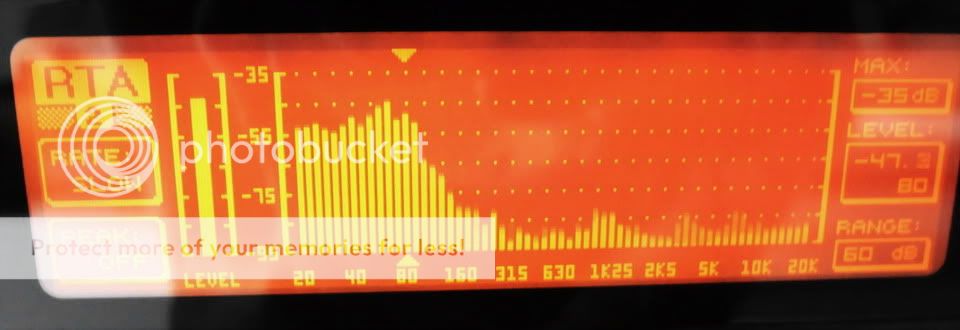
I put the cursor at 80Hz to show its harmonics which are all over. It fills the whole 20~80Hz! I was shocked.
@25Hz:
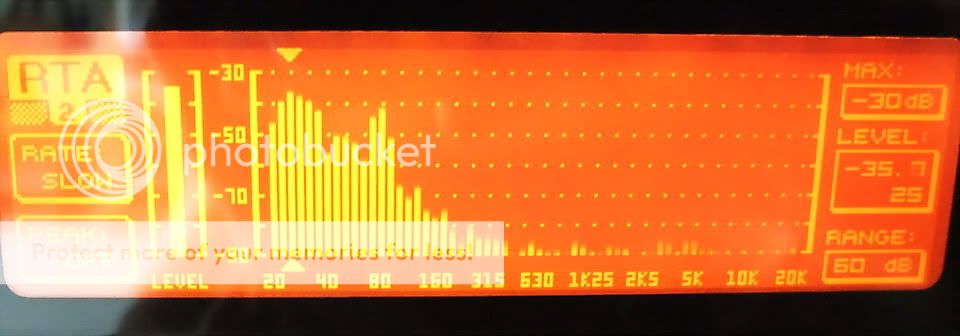
Huge 3rd, only a few dB down of the fundamental
@32Hz:
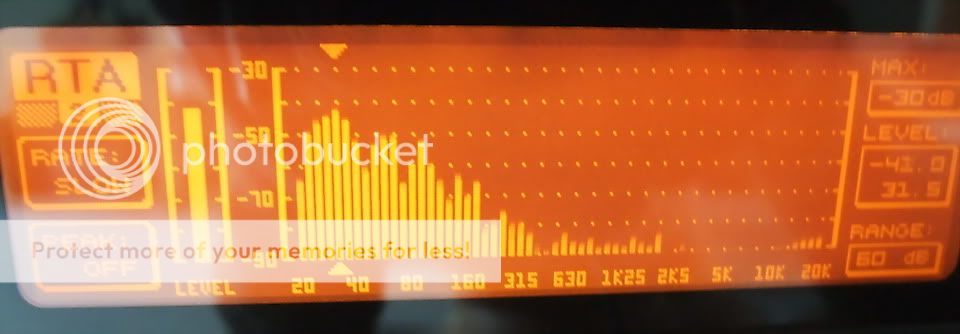
Getting better, but still nothing to write home about.
@35Hz:
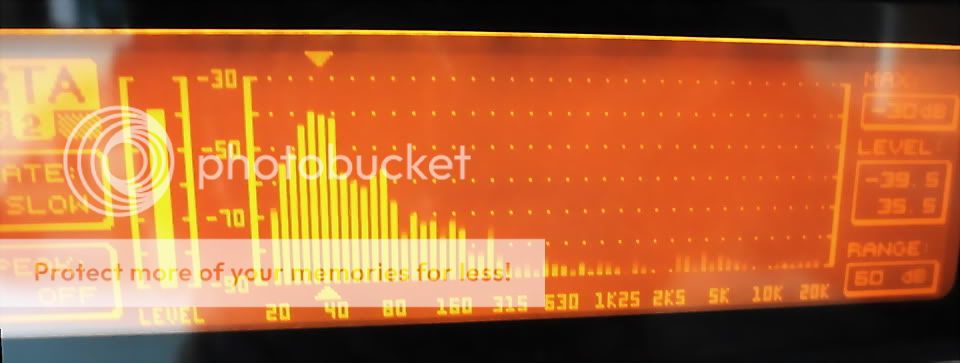
Better
@40H:
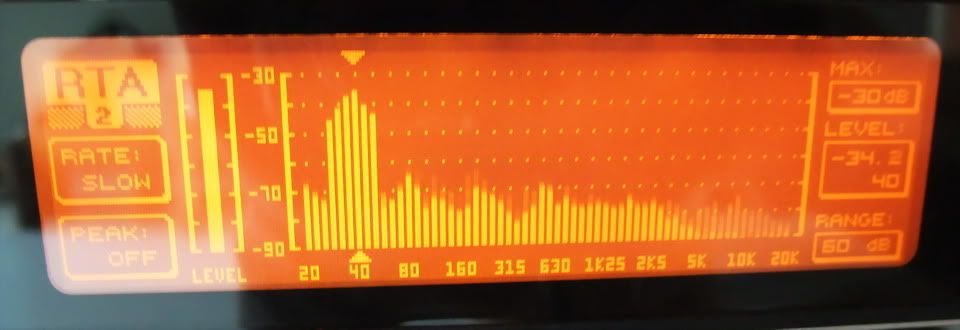
(please ignore those above 100Hz, those were the activities of my families)
So, what I thought 20-some to me is actually coming with a LOT of (unwelcome) extras How stupid.
How stupid. And I finally realize, why I always need to EQ down 60~80Hz range of my system somewhat, or it'd sound too heavy-footed. They are the harmonics of the 20-some.
And I finally realize, why I always need to EQ down 60~80Hz range of my system somewhat, or it'd sound too heavy-footed. They are the harmonics of the 20-some.
Later I tried cutting down those below 25Hz by a steep notch centered at 20 to -75dB max. And re-listened to those materials which have bottom end information. It's cleaner. And I brought back 60~80Hz for 2dB, it's even better.
A good lesson learnt. It's somewhat painful and shameful to know I was wrong, but good to know it's not going on.
Thank you guys.
I have to admit.
StigErik, you are right about the LF distortion.
twest820, good choice of the 35Hz lower limit.
I did some rough measurements by a function generator and RTA of my DEQ2496. Nothing is calibrated. Just give myself and all of you a rough idea.
I gave the woofers a good workout, all 4 of them were doing this:
YouTube - Eminence SigmaPro18 doing 20Hz.AVI
It's doing 20Hz sine wave fed by function generator, I've never seen them doing such excursion except the (in)famous dinosaur's footsteps. There's very few audible "sound" when doing this, even with such amplitude. When playing normal materials, it'd be deafening loud.
Ok, the fun (sad) parts:
@20Hz and the level as the short video above:

I put the cursor at 80Hz to show its harmonics which are all over. It fills the whole 20~80Hz! I was shocked.
@25Hz:

Huge 3rd, only a few dB down of the fundamental
@32Hz:

Getting better, but still nothing to write home about.
@35Hz:

Better
@40H:

(please ignore those above 100Hz, those were the activities of my families)
So, what I thought 20-some to me is actually coming with a LOT of (unwelcome) extras
Later I tried cutting down those below 25Hz by a steep notch centered at 20 to -75dB max. And re-listened to those materials which have bottom end information. It's cleaner. And I brought back 60~80Hz for 2dB, it's even better.
A good lesson learnt. It's somewhat painful and shameful to know I was wrong, but good to know it's not going on.
Thank you guys.
Last edited:
Yup. Like you, I was unaware of Stig Erik's build thread where he explored no baffle last fall until I happened to stumble across it early this year. I'd arrived at similar conclusions independently but his build pushed my thinking along quite a bit. However, I didn't have his build budget or listening space so I had to find a different way to accomplish more or less the same thing.The lack of any box resonances and less room mode exitation for sure make a difference
Since the high on your 15XA38Nds is running full range the forward directivity should decent. You can simulate in Edge to get a better sense of what exactly the high's doing, but the dipole peak of a nude 15 is usually around 650Hz with reasonably good directivity persisting up to a kHz or so. Makes for an easy handoff since the compression driver comes down to 700Hz. Beyma's datasheet doesn't seem to state the measurement conditions for the directivity figure, but I'd guess they're similar to what you're doing. So I'd definitely stick with dipole for the bass to maintain consistent directivity. In particular, if you listen nearfield with a baffle you may be able to pick up bass boost by being close enough to the drivers the rear wave hasn't diffracted around to cancel the front wave. (Bass boost happens nude, but you have to be quite close to the drivers. As in like 20cm from an 18.)
That's a good suggestion, thanks! I haven't experimented with toe in on dipoles since with box speakers I always found I preferred no toe. I simply got in the habit of leaving the speakers straight.While looking at your pictures I wondered if pointing the rear axes of your drivers (can't speak of the baffles any longer) more into the adjacent room corners and less to the windows might have positive results.
Something Lynn Olsen is prone to observing is different people hear differently. If you put an earplug in your right ear and highpass the tweeter around 6kHz you'll replicate the basics of my hearing, though I don't think there's any way to replicate my experiences growing up with the hearing loss. I've gotten better at localization over the years but when I was a kid I'd have to walk back and forth listening to wether a sound was getting louder or softer to triangulate where it was coming from.
When your bass lifts, how far does it lift? Some of the reduced compactness I'm hearing could be the same thing---I'm at 50cm center to center so our systems are not all that different and, to the extent I can localize, it sounds like the 18s are smeared up into where the Neos are. You could also decribe it as a ghost image of each 18 sitting on top the actual 18. That's about what I'd expect from the underlying physics. I formed the perception first and then thought about what would cause it, so I would bet there's more going on here than just me hearing what I'm expecting to hear.
That's where I end up looking as well. I've only measured half a dozen or so different drivers and the Neo10 is easily the cleanest in this regard, but my experience is minimum phase theory tends to be a good predictor of large scale phase behavior but the details are often loosely coupled. For example, 6dB/octave roll off is well established between 200 and 1.3kHz on the Neo10 but it's not clear to me if the phase flattens out to match the linear SPL or not. Similarly there's only a 60 degree phase shift across the transition from the 3-6kHz flat to the 200Hz-1.3kHz dipole roll off region. With the other drivers I've measured it's been easy to treat phasing in the dipole roll off as the tail of the phase shift around Fs. I think the Neo10 data admits that interpretation as well but the correlation with predicted minimum phase behavior is good enough I'm inclined to second guess that. I recrunching the Neo10 measurements to remove excess phase and found smoothing them at 1/8 octave brought out the best hints at SPL to phase correlation. Such data massaging tends to make me a bit uncomfortable but I've attached the result so you can take a look at it too.I think the mid shows it best between say 100 and 7K.
Do you have a link to John's proof? Every time I've looked at this I've been unable to prove the system has no all pass portion and hence I'm always left with results which admit behavior other than minimum phase. One possibility I'm kicking around is while the ideal driver is minimum phase real drivers are not ideal and hence have some amount of all pass behavior---they're certainly not point source dipoles. It may be the Neo10 is good enough the all pass portion is minimal and the underlying minimum phase behavior starts to show through more clearly.
I've had more than a few similar moments. Don't sweat it, just listen to the physics. The physics is smarter than all of us. But if you listen carefully it'll tell you how to build a better speaker.A good lesson learnt. It's somewhat painful and shameful to know I was wrong, but good to know it's not going on.
35Hz just fell out of my initial EQ setup so I really can't take too much credit for it. I did somewhat arbitrarily decide to stick with it as it's where close mic measurement shows the 18SWS1100s dropping below -40dB THD but I need set up a spec an capability like yours to properly evaluate the performance.
Attachments
Rudolf, I cannot agree with placing a hard object too close behind the speaker. ANY reflective surface too close to a loudspeaker will cause a smearing of the sound.
Maybe my perspective of coming from the studio world changes my hearing preferences, but I find that the additional reflections from the room, while maybe adding a sense of additional ambiance, destroy the original intention of the recording. IF the original recording has a good captured ambiance, for example many older Chesky recordings done by Bob Katz, then the playback system only needs to fully reveal the recording for an amazing sonic landscape. If the room is allowed to contribute too much, the perspective of the recording becomes washed out and more diffuse.
I mention Bob Katz, because he lives in town, I do work for him and have heard the original 24/96 masters of many of these recordings. He agrees with me that dipoles "cheat" by adding their own, additional ambiance to the recording. Perfectly fine as long as you know it is not exactly accurate.
I personally am after a sound closer to that of a good direct radiator boxed system, just without the box. Weird, I know.
Greg
Maybe my perspective of coming from the studio world changes my hearing preferences, but I find that the additional reflections from the room, while maybe adding a sense of additional ambiance, destroy the original intention of the recording. IF the original recording has a good captured ambiance, for example many older Chesky recordings done by Bob Katz, then the playback system only needs to fully reveal the recording for an amazing sonic landscape. If the room is allowed to contribute too much, the perspective of the recording becomes washed out and more diffuse.
I mention Bob Katz, because he lives in town, I do work for him and have heard the original 24/96 masters of many of these recordings. He agrees with me that dipoles "cheat" by adding their own, additional ambiance to the recording. Perfectly fine as long as you know it is not exactly accurate.
I personally am after a sound closer to that of a good direct radiator boxed system, just without the box. Weird, I know.
Greg
Totally agree with you there studiotech.
That's why I have a almost totally dead front end in my room, so the rear wave of the dipoles is more or less killed. This is quite the opposite of what Linkwitz and others recommend, but I dont agree with them. I dont want reflections, and what remains of room ambience should be diffused and have the same frequency response as the direct sound. Only that way you will be able to hear all the hidden beauty that's there in almost every music recording.
That's why I have a almost totally dead front end in my room, so the rear wave of the dipoles is more or less killed. This is quite the opposite of what Linkwitz and others recommend, but I dont agree with them. I dont want reflections, and what remains of room ambience should be diffused and have the same frequency response as the direct sound. Only that way you will be able to hear all the hidden beauty that's there in almost every music recording.
Twest, I don't remember the thread with John's proof. He and JohnPM were arguing with Michael about his double minimum phase concept or whatever he calls it.
Remember the measured phase is affected by the tails of the frequency response on both the high and low end. dlr did a bunch of stuff with phase measurements in Calsod and found that all the real drivers tested are close enough to minimum phase for guv'ment work when you extend the tails before you do the Hilbert transform.
Another factor is microphone phase is hard to measure. Herb doesn't measure mic phase and just sets it to zero in the cal file. I use ARTA and it doesn't even use the mic phase data because he says it's too unreliable. So, for my purposes, I use minimum phase for the drivers rather than measured phase as I think it's more reliable. Doing that, you need to set the Z offset of the acoustic centers in the crossover software.
Remember the measured phase is affected by the tails of the frequency response on both the high and low end. dlr did a bunch of stuff with phase measurements in Calsod and found that all the real drivers tested are close enough to minimum phase for guv'ment work when you extend the tails before you do the Hilbert transform.
Another factor is microphone phase is hard to measure. Herb doesn't measure mic phase and just sets it to zero in the cal file. I use ARTA and it doesn't even use the mic phase data because he says it's too unreliable. So, for my purposes, I use minimum phase for the drivers rather than measured phase as I think it's more reliable. Doing that, you need to set the Z offset of the acoustic centers in the crossover software.
Totally agree with you there studiotech.
That's why I have a almost totally dead front end in my room, so the rear wave of the dipoles is more or less killed. This is quite the opposite of what Linkwitz and others recommend, but I dont agree with them. I dont want reflections, and what remains of room ambience should be diffused and have the same frequency response as the direct sound. Only that way you will be able to hear all the hidden beauty that's there in almost every music recording.
"Only" as long as we speak dipole yeah
...
That's why I have a almost totally dead front end in my room, so the rear wave of the dipoles is more or less killed. ....
Have you tried cardioid?
At the speed of how you build things, I guess we'll have lots of interesting works to see
Have you tried cardioid?
At the speed of how you build things, I guess we'll have lots of interesting works to see
Well, I'm a little slower than StigErik and probably not as thorough, but I am trying for more of a cardioid in-room response myself.
Greg
Yes, I've wondered about mic phase cals and hit essentially the same walls. If Ask has documented how he implemented HOLMImpulse's phase calculations I haven't found where, but knowing him it's probably pretty decent. I would guess I have measurement accuracy of 10 or 15 degrees, though phase gets kinda arbitrary on the high end where microsecond shifts in the reference point create movements of several degrees---my pulse probably moves the position of my ears by more than the fraction of a millimeter sound covers in a microsecond. From around 2kHz on down I have reliable descrimination to what measures out to 30 degrees or so and statistically significant discrimination probably to 15 degrees.[good stuff about phase]
So I'm tempted to call the Fs+dipole EQ phase compensation method I'm using good enough---while it may or may not align with the underlying driver physics, it seems to produce flat phase within the limits of measurement ability, subjective perception, and our understanding of driver behavior. There should be some way to move forward here though. But I'm not seeing obvious next steps. Any ideas?
I'll chime in here. I considered a cardioid build, but consistent directivity requires U baffles all the way up. That's tricky, and the easy to build U shape is likely not optimal from a sound reproduction standpoint. Stig Erik's approach of a dead end behind the speakers is probably quicker and easier. Though not necessarily as much fun.Have you tried cardioid?
Hi Greg,
Your panels looks impressive, too. I'm looking forward to see your further progress. Especially some more measurements - love to see how Dipole 15 performs in the bass.
Hi twest,
You're probably right in a practical view.
I myself tried the cardioid concept shortly on a single wideranger on OB with the whole back covered with 2 layers of 10mm thick felt. The acoustic character of that felt is obvious frequency dependent - it absorbs much more mid-high than low. So it affects the overall in room response - more or less like adding a shelfing filter which suppresses the mid-high.
It was uncompleted and obvious didn't sound right to me at that stage, but I didn't pursue further because of some other things. And I remember I got a feeling (or instinct?) that it's not easy to get right... Can't comment anymore meaningful.
Your panels looks impressive, too. I'm looking forward to see your further progress. Especially some more measurements - love to see how Dipole 15 performs in the bass.
Hi twest,
You're probably right in a practical view.
I myself tried the cardioid concept shortly on a single wideranger on OB with the whole back covered with 2 layers of 10mm thick felt. The acoustic character of that felt is obvious frequency dependent - it absorbs much more mid-high than low. So it affects the overall in room response - more or less like adding a shelfing filter which suppresses the mid-high.
It was uncompleted and obvious didn't sound right to me at that stage, but I didn't pursue further because of some other things. And I remember I got a feeling (or instinct?) that it's not easy to get right... Can't comment anymore meaningful.
If you gotta have 120 probably your best option is to sacrifice vertical directivity and use push/pull pairs the way StigErik does.
Just arrived:
http://www.scan-speak.dk/datasheet/pdf/15m-4624g00.pdf
Not exactly 120dB though...
Michael
- Status
- This old topic is closed. If you want to reopen this topic, contact a moderator using the "Report Post" button.
- Home
- Loudspeakers
- Multi-Way
- the three way nude swinging dipole thread
